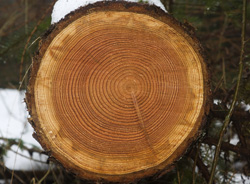Tree rings provide answers to climate change
Increasing levels of atmospheric carbon dioxide (CO2) are expected to have a major effect on plant physiology and can already be observed in tree-ring carbon-13 (13C) composition. Carbon-13 is a radioactive isotope taken up by plants that can be used by scientists to analyse tree rings and discover details about our planet’s climate in past centuries. However, an incomplete understanding of the relationship between climate factors, physiological responses in plants and the resulting isotopic signals has restricted the use of tree-ring isotopes in climate change studies. The 'Ecophysiological aspects of tree ring isotopes' (Ecotri) project was a multidisciplinary study that investigated how leaves affect the composition of isotopes in the cellulose that forms tree rings. Scientists examined the movement of different concentrations of CO2 in the leaves of the European Black Pine (Pinus nigra). This was achieved by conducting a detailed analysis of leaf sections during the transition of the light and dark phases of photosynthesis. Measurement of leaf temperature using high resolution infrared thermography revealed that temperature gradients from the warmer central mid-vein to the cooler leaf edge were more pronounced than along the length of the leaf. The results were used to test a model of leaf structure and accurate simulations of factors that can modify the uptake of C13, including respiration and cellulose production. Findings from the Ecotri project increased knowledge of tree-ring isotopic composition and their use in reconstructing past climate conditions. The data also enabled scientists and decision makers to make more accurate predictions of how plants will be affected by future changes to the climate and which adaptation strategies should be followed.







